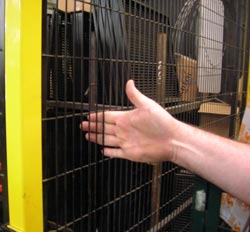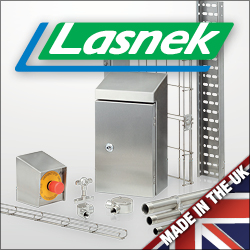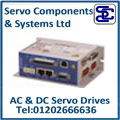
Posted to News on 17th Mar 2014, 12:10
Ten things you need to know about machine guarding standards
This article presents ten things that machine designers and specifiers should know about machine guarding standards, and the information will also be useful for production managers, health and safety managers, health and safety representatives and others with an interest in machinery safety.

Guarding needs to be well designed if a machine is to operate safely and efficiently. Furthermore, guards should not be expensively over-engineered, nor should they detract from the machine's aesthetics. In all cases, however, they should be designed in accordance with the applicable national and international standards. This article presents ten things that machine designers and specifiers should know about machine guarding standards, and the information will also be useful for production managers, health and safety managers, health and safety representatives and others with an interest in machinery safety.
1 - Compliance is not mandatory
This first point may come as a surprise, but there is no legal requirement (at least in the UK and Europe) to comply with machine guarding standards. However, compliance with the relevant standards, especially those harmonised to the Machinery Directive, is generally the best way to demonstrate that the Essential Health and Safety Requirements have been met, so compliance with the standards is strongly recommended.
2 - BS EN ISO 14120, the main standard for machine guarding
BS EN ISO 14120:2015, Safety of Machinery. Guards. General requirements for the design and construction of fixed and movable guards, covers all types of machinery, from simple drive couplings to very complex installations involving robots, conveyors and processing machinery. The standard lists those aspects of machinery, people and guards that need to be considered. However, using BS EN ISO 14120 does not mean that other standards can be ignored; for example, see point 4 below. Note that ISO 14120 recently replaced EN 953 and Procter Machine Guarding's experts have prepared a White Paper explaining the differences between ISO 14120 and EN 953.
3 - Standards for machine risk assessments
For over a decade machine builders used BS EN 1050, Safety of machinery, Principles for risk assessment, as the starting point for designing machine guards. This was withdrawn and superseded by BS EN ISO 14121-1:2007, Safety of machinery, Risk assessment, Principles, but this has, itself, been withdrawn and superseded by BS EN ISO 12100:2010, Safety of machinery. General principles for design. Risk assessment and risk reduction. This latest standard is actually an amalgamation of the old risk assessment standard with BS EN ISO 12100-1, Safety of machinery. Basic concepts, general principles for design. Basic terminology, methodology, and BS EN ISO 12100-2, Safety of machinery. Basic concepts, general principles for design. Technical principles. To help machine builders and users undertake machine risk assessments, Procter Machine Guarding has produced a BS EN ISO 12100:2010 Risk Assessment Calculator, which is based on an Excel spreadsheet. It is available free of charge on request or can be downloaded from the company's website.
4 - Safety distances for upper and lower limbs
BS EN ISO 13857:2008, Safety of machinery. Safety distances to prevent hazard zones being reached by upper and lower limbs, superseded both BS EN 294 (the standard relating to upper limbs) and BS EN 811 (lower limbs). BS EN ISO 13857 contains tables and data to enable guards to be designed with an acceptable combination of height, horizontal distance from the hazard, and aperture size (for guards with mesh infill, or other openings in guards). Unfortunately the standard is not as user-friendly as might be hoped, and the results can be ambiguous. Procter Machine Guarding has therefore developed a spreadsheet-based BS EN ISO 13857 Safety Distance Calculator with drop-down menu selections that simplify the task and avoid ambiguities. The safety Distance Calculator is available free of charge on request or can be downloaded from the company's website.
5 - Ergonomic standards
Ergonomics (often called human factors) is the study of human interaction with equipment and devices, covering both physical and mental aspects. Because guarding plays such an important role in the interaction between users (including maintenance personnel) and the machine, it is vital to consider ergonomic issues to avoid compromising safety or productivity. Not surprisingly, there are numerous ergonomics standards, such as BS EN 614-2:2000+A1:2008, Safety of machinery. Ergonomic design principles. Interactions between the design of machinery and work tasks.
6 - Standards for specific types of machine
So far we have discussed general machine safety standards, but it should be remembered that there are dozens of standards, known as Type C standards, relating to specific classes of machinery. For example, BS EN 12417:2001 +A2:2009, "Machine tools. Safety. Machining centres'. Type C standards may well contain specific requirements in relation to guarding, so designers should check whether there are any Type C standards for the machine on which they are working, as this can avoid the need to work 'from first principles.'
7 - Current, withdrawn and superseded standards
Some standards remain current for long periods, or are simply subject to minor amendments. For example, BS 6753:1986, Specification for shotbolts (solenoid operated) for guarding machinery has been current for 30 years. In contrast, BS EN 1050:1997 (risk assessments) was replaced ten years later by BS EN ISO 14121-1:2007, and this latter standard was itself withdrawn and superseded after just three years. Keeping up to date with standards is the responsibility of the guarding designer, who might choose to subscribe to British Standards Online (BSOL), the online standards management service from BSI, or instead monitor relevant news-based websites and subscribe to free email newsletters from publishers and companies such as Procter Machine Guarding.
8 - PD 5304, a useful ex-standard
PD 5304:2014, Guidance on safe use of machinery, is available from BSI and has the status of a Published Document. While not a standard, it has evolved from BS 5304:1988, the old British Standard for machinery safety, and contains a wealth of useful guidance and practical examples of guard design. Many of today's machine safety standards incorporate principles contained in PD 5304, but lack the illustrative examples found in the Published Document. Procter Machine Guarding has recently published a White Paper explaining the changes in the 2014 edition of PD 5304.
9 - Other official guidance
Standards are very helpful when designing machine guarding, but there are also other sources of official guidance. For example, here in the UK the HSE (Health and Safety Executive) has pages on its website for New machinery, CE marking and Refurbished and modified machinery.
10 - Free guide to machine guarding standards
Points 1-9 above are based on material contained in On Your Guard - A Designer's Guide to Machinery Guarding Standards, which has recently been updated. This is recommended reading for anyone involved in specifying or designing machine guards, as well as production managers, health and safety managers, health and safety representatives and others requiring an understanding of this important subject. Follow the link to download this and other free guides, white papers and calculators from the Procter Machine Guarding website.



















